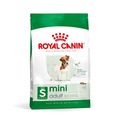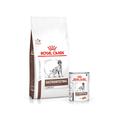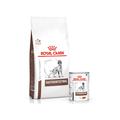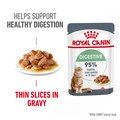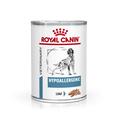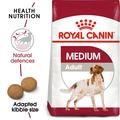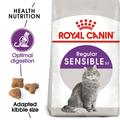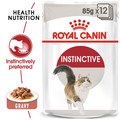If your vet has discussed using ROYAL CANIN® ANALLERGENIC or ROYAL CANIN® HYPOALLERGENIC diets with you, we’re sorry to hear that your pet is experiencing problems but we’re here to help you understand how these diets may help. They sit within our Veterinary Health Nutrition range and can be used to help diagnose and support pets with a range of health conditions including certain skin conditions and digestive disorders. The diets should be fed following recommendation from a vet and on-going supervision is advised.
What types of diets are they?
One of the main reasons for using these diets is to help diagnose and support pets with food allergies and nutrient intolerances, part of a group of issues known as adverse food reactions. Adverse food reactions are one of many potential causes of skin problems in dogs and cats; there are other, more common causes such as parasites, allergens in the environment and other hormonal issues.
In the unlikely case of a true food allergy, the dog or cat’s immune system reacts to a protein source that healthy pets eat and digest normally. Most pet foods contain intact, whole proteins such as those found in chicken, beef and fish for example. The size of proteins (their molecular size) can vary considerably and is measured in the unit of kilodaltons (kDa), more on this later! The immune system mistakes the protein as a potential threat and reacts by triggering an allergic reaction which may manifest in symptoms such as itching, redness of the skin and in some cases loose stools or vomiting.
The difference with these two diet ranges is that they use protein sources that have been ‘hydrolysed’. This means the proteins are basically cut down using enzymes into much smaller pieces like what happens in normal digestion. Due to the smaller molecular size, the immune system does not recognise these very small proteins as a threat, so no allergic response is triggered and the essential proteins needed by the pet are absorbed and used. Another way to think of it is like the key (the protein) now being too small to fit the lock (the immune system) so the door (allergic response) doesn’t open!
It’s important to say that these diets are not the same as other pet foods that may include the word ‘hypoallergenic’ somewhere on the packaging. This term simply means ‘less likely to cause an allergic reaction’ and was first used as a marketing term by human cosmetic companies. When relating to pet food, there is no legal definition; it can mean that a diet is made with a single protein source, or that the protein source used is less likely to cause an allergic reaction. However, often it is simply a marketing gimmick because true food allergies are very rare and are usually attributed to meat proteins with beef, fish and chicken being the top three culprits in cats and beef, dairy and chicken in dogs; all of these are often found in so-called hypoallergenic pet foods. Additionally, many studies using DNA analysis have shown significant cross contamination in almost all pet foods sold as ‘single protein source’.
Hydrolysing the proteins as described above is the scientifically proven, reliable way to ensure that a diet is less likely to trigger allergic reactions. For this reason, hydrolysed diets, such as ANALLERGENIC, are recommended by vets when carrying out food elimination trials. When trying to establish the underlying cause of skin problems, a food elimination trial is often recommended by a vet for the owner to follow. This involves feeding one food for a fixed period (usually 6-8 weeks) with absolutely no other pet foods, treats or human foods to check how the symptoms change and help work out if something in the pet’s diet was contributing to the problem.
When manufacturing these hydrolysed protein diets, there are rigorous cleaning and preparation protocols in place to limit the chance of any contamination on the production line together with extensive quality and food safety checks on both the raw ingredients and finished product.
So both ranges are hydrolysed, what are the differences between them?
The main differences between the two ranges lie in the molecular size of the protein, the sources of the protein and carbohydrate used and the formats and products available.
ROYAL CANIN® HYPOALLERGENIC was the first hydrolysed protein diet range we launched that uses hydrolysed soya protein and hydrolysed poultry liver. The size of the protein molecules was able to be reduced to between 3-15kDA. To give context, the size of the intact proteins involved when an allergic reaction occurs are generally between 15-40kDA depending on the source. This meant that most food-allergic pets would respond well to being fed this diet solely.
Although hydrolysed diets were a great step forward in the management of food-allergic pets, our commitment to advancing product innovation continued as there was still a minority of food allergic pets that were still reacting, despite being fed on the hydrolysed HYPOALLERGENIC diet. In our key and lock analogy, there was still the odd small key that was just big enough to fit the lock and open the door to a reaction!
Finally, in 2012, following 10 years of research, ROYAL CANIN® ANALLERGENIC diet was launched. The novel and unusual protein source is a protein extracted from feather which is extensively hydrolysed so that the molecular protein size is reduced further to less than 1kDA. Proteins of this size cannot be recognised in the body as a protein source and therefore can confidently be used for the diagnosis of food allergy when the diet is fed as the sole food source in an elimination trial. Or in other words, no key is big enough to fit the lock!
In the HYPOALLERGENIC range for dogs there are 3 dry diets; standard, moderate calorie and one for small dogs under 10kg in body weight, all of which use rice as the carbohydrate source. There is also a wet food available in a can that has a ‘loaf’ texture and uses pea starch as the selected carbohydrate source. For cats, there is currently just the dry diet available that also uses rice as the carbohydrate source.
In the ANALLERGENIC range, there is one dry diet for dogs and one for cats. Both use a purified form of maize starch for the carbohydrate part of the diet so that no additional proteins from the maize could be included which might skew the results when doing a food trial. We are always striving to advance our product innovations and with continued research new diets will continue to be launched so watch this space!
Scenarios on using one range over another
Due to the extensive hydrolysis of the proteins in the ANALLERGENIC diets, these should be the first port of call to be fed as part of diagnosing suspected food allergies when a food elimination trial is needed. When the trial is done correctly, if there is no improvement in the pet’s symptoms following 6-8 weeks of sole feeding, a food allergy can confidently be ruled out and other causes explored. If the symptoms improve or resolve completely during the elimination trial, a food allergy can be diagnosed and the original food or individual protein ingredients can be re-introduced one-by-one to the pet to see which cause the symptoms to return. For ongoing management, ANALLERGENIC can be fed life-long if required or sometimes vets may recommend trying the HYPOALLERGENIC range or another non-hydrolysed selected (single source) protein diet, once the allergenic protein source has been identified.
For dogs, if a hydrolysed wet food is required or the dog needs to be fed with wet and dry food, this would be when the HYPOALLERGENIC range would be recommended for the elimination trial as more texture formats are available. Also, if there was a specific health need for a moderate calorie or small dog version.
In the unlikely event of a food allergy being suspected in a puppy or kitten, please refer to your vet for further guidance on the most suitable foods to use.
In summary, both the diagnosis and management of skin conditions can be a lengthy and step-by-step process to reach an accurate diagnosis and robust future management plan; hydrolysed diets play a key role. As the diets are often used alongside other methods such as medication and lifestyle management, your vet’s advice should always be sought before using these diets and before any changes are made to the diet once it is being fed.
Written by: Erica Moorhouse, Scientific Communications Manage (Guest Author)

